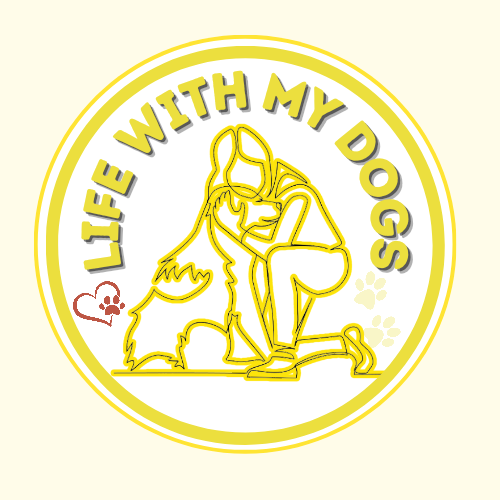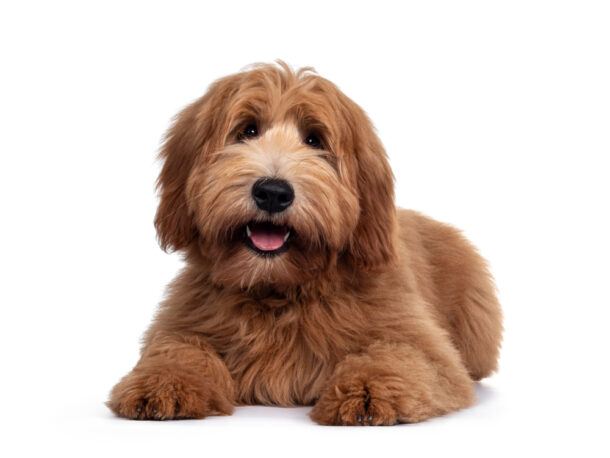LifeWithMyDogs is supported by our audience. When you purchase through one of our links, we may earn a small affiliate commission. As an Amazon Associate I earn from qualifying purchases. Your cost is not affected.
**********
Living in an apartment with multiple dogs can be a real adventure, especially when space is limited. But with a little creativity and smart planning, you can create a happy, harmonious home for all your pups, no matter how cozy the quarters. Whether you’re balancing different personalities, managing energy levels, or simply trying to avoid tripping over a wagging tail, this guide will help you keep things peaceful and organized. From smart layout ideas to tips on fostering a strong pack dynamic, let’s dive into what it takes to make multi-dog apartment living work smoothly.
Multi-Dog Households in Apartments: Creating Harmony in Small Spaces
Living with multiple dogs in an apartment can be rewarding and fun. With the right planning and management, it’s totally doable. The key is to plan ahead and be ready to manage any issues that come up. While we did not live in an apartment with more than one dog, our family lived for many years in a small home with several dogs. I have experience in managing to maintain harmony.

Space may seem tight, but there are ways to make it work. I use baby gates and crates to give each pup their own area when needed. It’s also important to give each dog one-on-one time every day. This helps strengthen our bond and keeps everyone happy.
Before adding another dog to your apartment, it’s smart to think it through. Consider your current setup, lifestyle, and building rules. With some prep work, you can create a loving home for multiple furry friends, even in a smaller space.
Benefits of Having Multiple Dogs
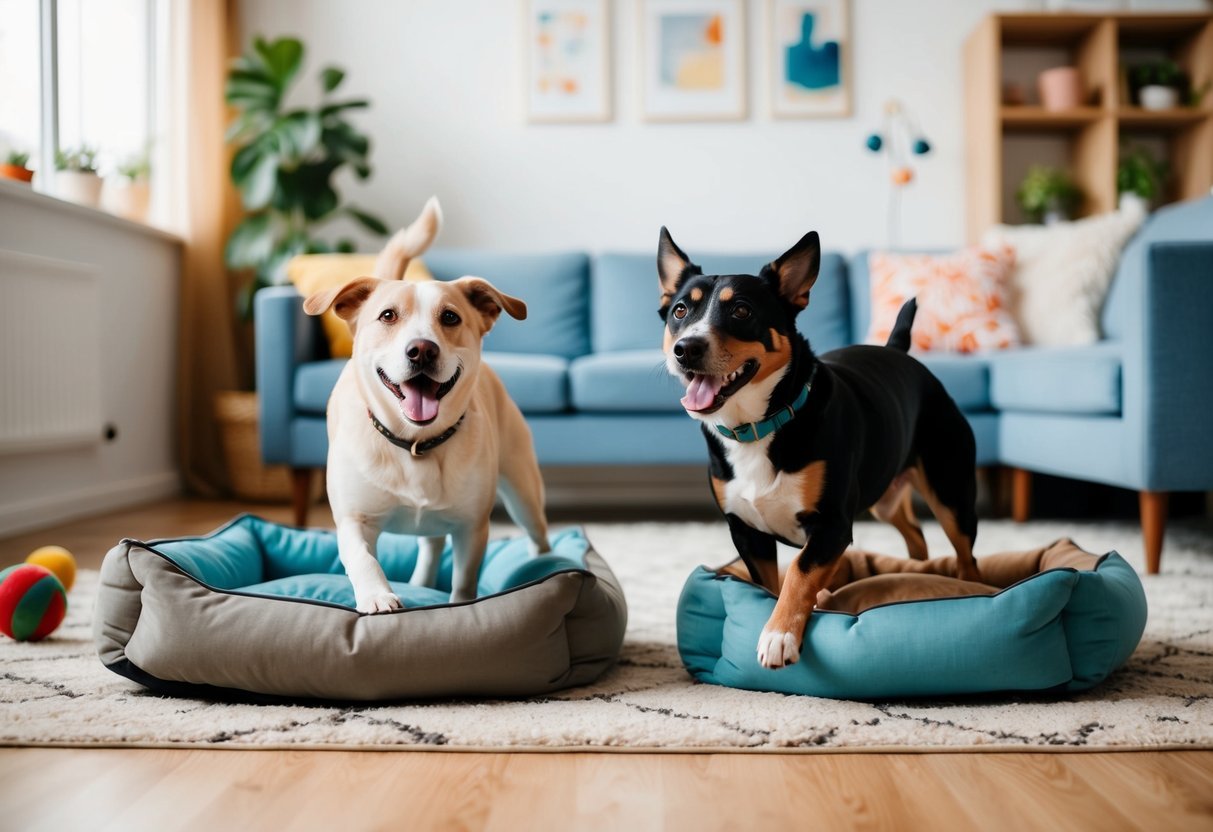
I’ve found that having more than one dog brings many joys to my life. The emotional benefits of multiple dogs are truly amazing. My pups always have a playmate, which means they’re rarely bored or lonely. This helps keep them happy and active, even when I’m not home. I love watching my dogs interact and play together. Their antics never fail to make me smile and laugh. It’s like having a constant source of entertainment right in my living room!
Multiple dogs can enhance each other’s well-being. They provide companionship and comfort to one another, which can reduce anxiety and stress. My multi-dog household also helps me stay active. With two or more dogs to walk and play with, I get plenty of exercise without even trying. Having multiple dogs has improved my social life too. Dog parks and group walks are great ways to meet new people and make friends.
I feel safer with multiple dogs around. They’re always alert and ready to warn me of any potential dangers. Lastly, the love I receive from my pack is multiplied. There’s nothing quite like coming home to a group of wagging tails and happy faces!
Understanding Apartment Restrictions
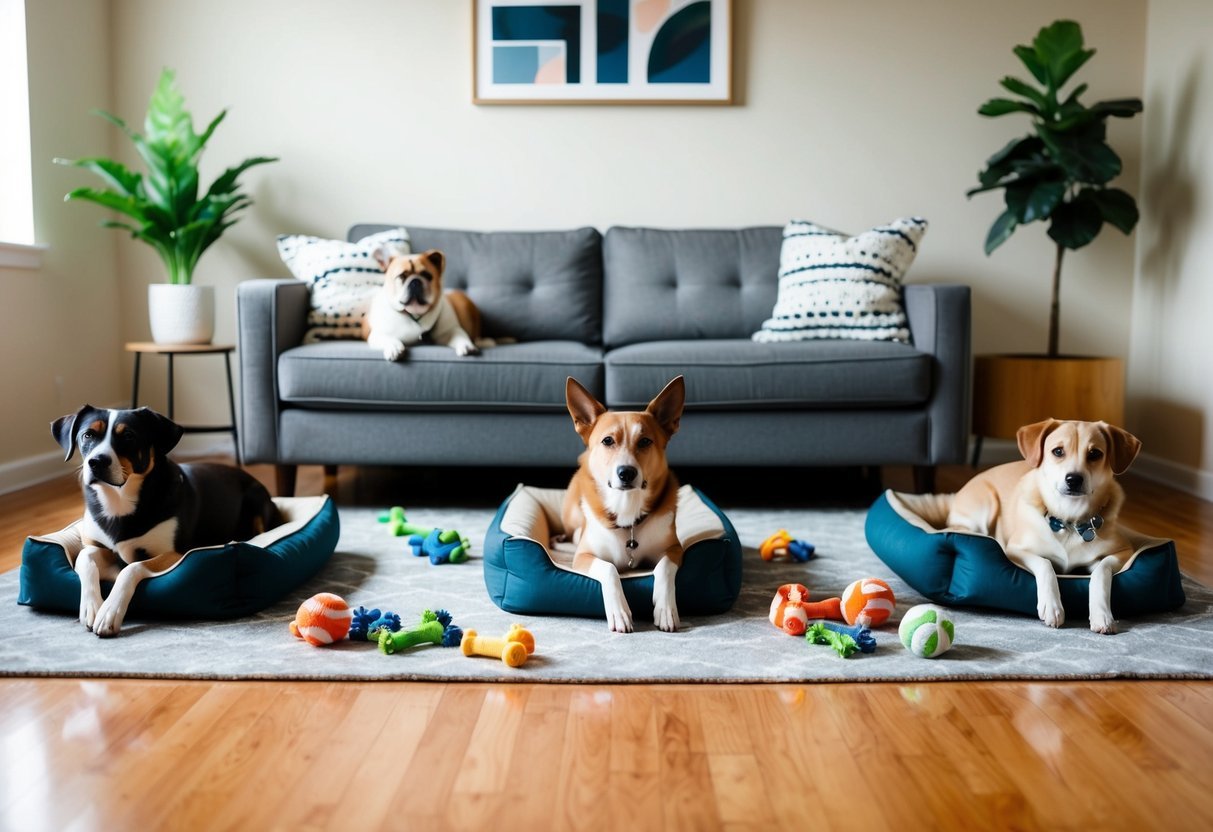
Living with multiple dogs in an apartment can be tricky. Many places have rules about pets. I’ve learned that it’s important to know these rules before moving in. Some apartments limit the number of dogs you can have. They might say only one or two are allowed. Weight limits are common too. Some places don’t allow dogs over 25 or 50 pounds.
Breed restrictions are another big issue. Certain breeds like pit bulls, Rottweilers, and German shepherds are often not allowed. This can be tough if you have a mixed breed that looks like one of these dogs. I’ve found that some apartments charge extra fees for pets. These might include:
- Pet deposit
- Monthly pet rent
- Additional cleaning fees
It’s a good idea to ask about all costs upfront. Some places also require proof of vaccinations and licenses for your dogs. Rules can vary a lot between different apartments. I always make sure to read the lease carefully and ask questions about anything that’s not clear.
Choosing the Right Dogs for Apartment Living
When I think about dogs for apartments, size isn’t the only factor. I’ve found that energy level and temperament matter just as much. Some smaller breeds can be quite energetic, while larger breeds might be couch potatoes. I always recommend considering these traits for apartment dogs:
- Low to moderate energy levels
- Quiet or easily trainable to be quiet
- Friendly with neighbors and other dogs
- Adaptable to small spaces
Some breeds I’ve seen do well in apartments include:
- French Bulldogs
- Greyhounds (surprisingly!)
- Cavalier King Charles Spaniels
- Shih Tzus
Maltese dogs are another great option for small spaces. They’re tiny, don’t shed much, and are generally calm. I’ve noticed that many medium-sized breeds can thrive in apartments too. Basset Hounds and Whippets are good examples. They’re usually laid-back and don’t need tons of exercise.
Remember, every dog is unique. I always suggest meeting a dog before bringing them home. This helps me get a feel for their personality and energy level.
Preparing Your Apartment
Getting your apartment ready for multiple dogs takes some planning. I’ll share tips on managing space, setting up separate areas, and keeping noise under control. These steps will help create a happy home for you and your furry friends.
Space Management
I’ve found that smart space management is key in a multi-dog apartment. First, I clear out clutter to make more room. I use vertical space by adding tall shelves or wall-mounted storage. This frees up floor space for my dogs to move around. I also rearrange furniture to create open areas. Pushing couches against walls can make a big difference.
I use multi-functional furniture like ottomans with storage inside. This gives me extra space to keep dog toys and supplies. For feeding time, I set up a compact feeding station. Wall-mounted food and water bowls save floor space. I also use collapsible bowls for easy storage when not in use.
Creating Separate Zones
I believe in giving each dog their own space. I set up separate sleeping areas with cozy beds or crates. This helps prevent conflicts and gives them a place to relax. I create designated play areas for my dogs. A corner with toys and a small play mat works well. I rotate toys to keep things interesting.
For potty training, I set up a specific spot near the door. Pee pads or a small indoor grass patch can be helpful. I make sure it’s easy to clean and away from living areas. I also have a shared space where all dogs can hang out together. This helps with bonding and socialization.
Noise Control
Keeping noise down is crucial in an apartment. I use sound-absorbing materials like rugs and curtains to muffle barking. Thick blankets over crates can also help. I provide plenty of chew toys to keep my dogs occupied and quiet. Puzzle toys are great for mental stimulation and can reduce boredom barking.
I work on training each dog to respond to quiet commands. This helps me quickly calm them if they get noisy. White noise machines or soft background music can mask outside noises that might trigger barking. I find this especially helpful in busy apartment buildings.
Daily Routines and Schedules
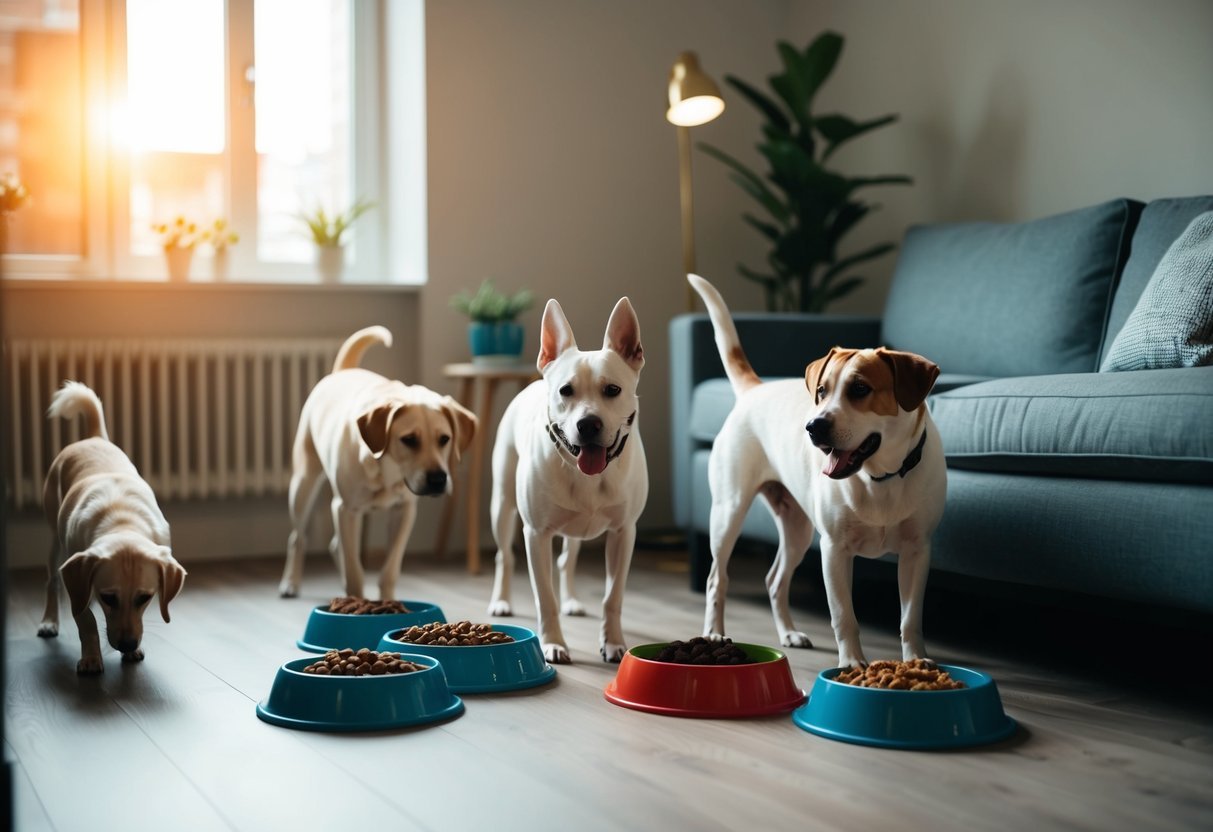
A good routine keeps my dogs happy and healthy in our apartment. I’ve found that sticking to a schedule for meals, walks, and one-on-one time makes a big difference.
Feeding Arrangements
I feed my dogs at set times each day. This helps prevent food fights and keeps everyone on track. I use separate bowls for each dog and space them out. This stops any pushing or stealing.
For my big eater, I use a slow feeder bowl to make meals last longer. I always supervise mealtimes. This lets me watch for any issues and make sure each dog finishes their food. After meals, I give them 30 minutes to digest before any play or walks.
Exercise and Walks
I take my dogs on walks twice a day. Morning walks are short, just 15-20 minutes to do their business. Our longer walk is in the evening. We go for 30-45 minutes, depending on the weather and how they’re feeling. I use a hands-free leash to walk them together. This gives me better control and keeps us all connected.
On rainy days, we play indoor games like hide-and-seek or tug-of-war. This helps burn energy when we can’t go out. I also do short training sessions daily. This keeps their minds active and reinforces good behavior.
Alone Time and Interaction
Each dog gets one-on-one time with me every day. This might be a special play session or extra cuddles. I use puzzle toys when I need to leave them alone. This keeps them busy and cuts down on boredom.
When I’m home, I make sure to give each dog attention. Even a quick pat or kind word helps them feel loved. I arrange playdates with dog friends when I can. This gives them new experiences and social time. Before bed, we have a calm-down routine. This includes gentle pets and quiet time to help everyone relax.
Behavioral Training
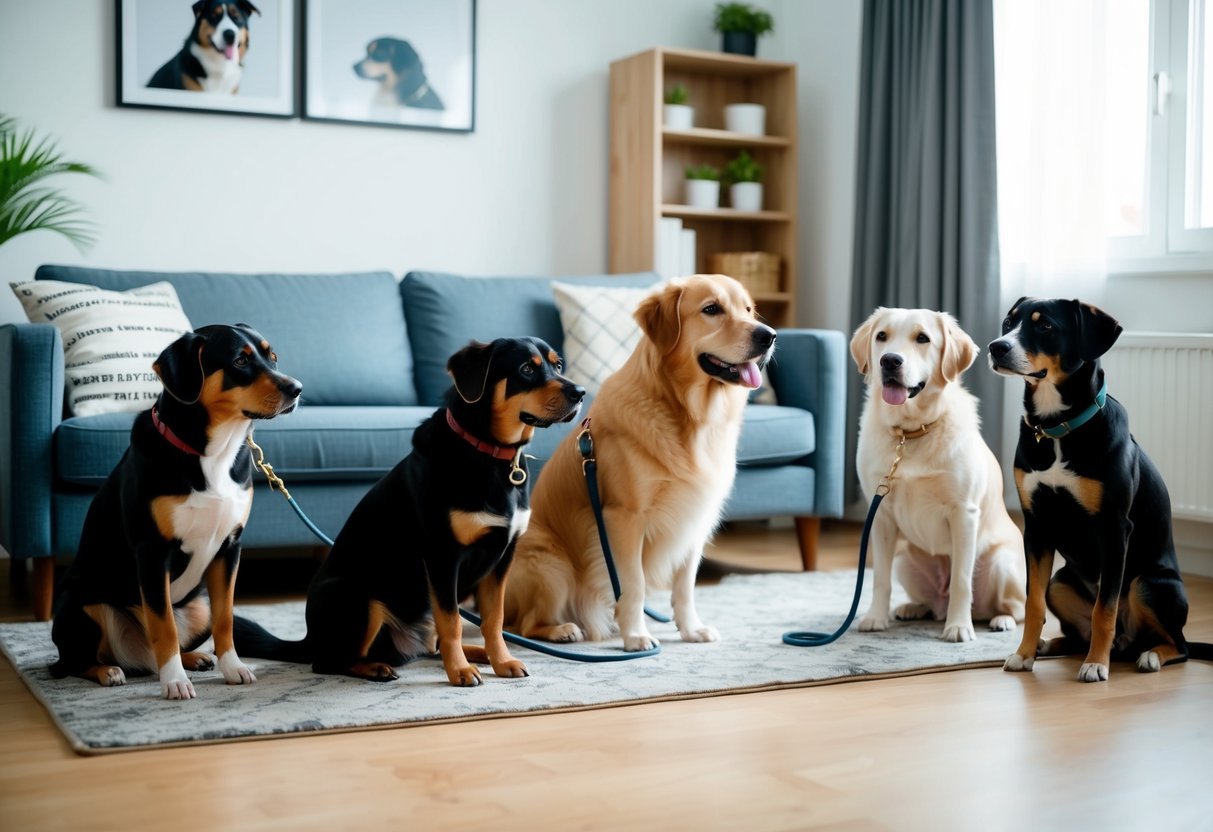
Training multiple dogs in an apartment requires patience and consistency. I’ve found that focusing on obedience, socialization, and managing problem behaviors is key to a harmonious multi-dog household in a small space.
Obedience Training
I always start with basic obedience commands like sit, stay, and come. These are crucial for maintaining control in tight quarters. I use positive reinforcement techniques, rewarding good behavior with treats and praise. Short, frequent training sessions work best in apartments. I aim for 5-10 minutes, 2-3 times a day. This keeps the dogs engaged without overwhelming them.
Teaching each dog individually before group training is important. Once they master commands alone, I gradually introduce distractions, including other dogs.
Socialization Techniques
Proper socialization helps prevent conflicts between dogs in close living spaces. I make sure to expose my dogs to various people, animals, and environments from an early age. I arrange playdates with compatible canine friends. This gives them practice interacting positively with other dogs outside our pack.
Group training classes are great for socialization too. They provide structured interaction and reinforce obedience in distracting environments. I also take my dogs on regular outings to parks or pet-friendly stores. This helps them stay comfortable with new experiences and reduces apartment-related boredom.
Managing Aggression and Anxiety
Living in close quarters can sometimes lead to tension between dogs. I watch for signs of aggression or anxiety and address them promptly. I use positive reinforcement to reward calm behavior around triggers. For example, if one dog gets anxious when another approaches their food bowl, I praise and treat them for staying relaxed.
Creating separate spaces for each dog is crucial. I use baby gates or crates to give them alone time when needed. This prevents resource guarding and provides a safe retreat. For severe cases, I don’t hesitate to consult a professional dog trainer or behaviorist. They can provide tailored strategies for managing aggression or anxiety in multi-dog apartments.
Health and Hygiene

Keeping multiple dogs healthy in an apartment takes effort. I’ll share tips on vet care, grooming, and handling emergencies to keep your pack in top shape.
Regular Vet Visits
I make sure to schedule check-ups for all my dogs at least once a year. It’s best to find a vet who’s comfortable with multiple-dog households. They can give tailored advice for my apartment setup. I keep a calendar with reminders for each dog’s vaccinations and preventive treatments. This helps me stay on top of flea, tick, and heartworm prevention.
For convenience, I’ve found mobile vet services that come to my apartment. This reduces stress for my dogs and saves me time.
Cleanliness and Grooming
In a small space, cleanliness is key. I vacuum daily and wipe down surfaces often to manage pet hair and dander. I’ve set up a grooming station in my bathroom. It has all the tools I need for brushing, nail trimming, and teeth cleaning. Regular grooming keeps my dogs looking good and helps me spot any health issues early.
For baths, I use a schedule to make sure each dog gets cleaned regularly. This helps control odors in the apartment. I also use air purifiers to keep the air fresh.
Dealing With Illness and Emergencies
I keep a first aid kit for my dogs in an easy-to-reach spot. It has basic supplies like bandages, antiseptic wipes, and any medications my dogs need. I’ve practiced what to do if one dog gets sick. I have a plan to isolate them in a separate room to prevent the spread to the others.
For emergencies, I have the number of a 24-hour vet clinic saved on my phone. I also keep copies of each dog’s medical records in a folder. This way, I’m prepared if I need to rush to the vet.
Legal and Financial Considerations
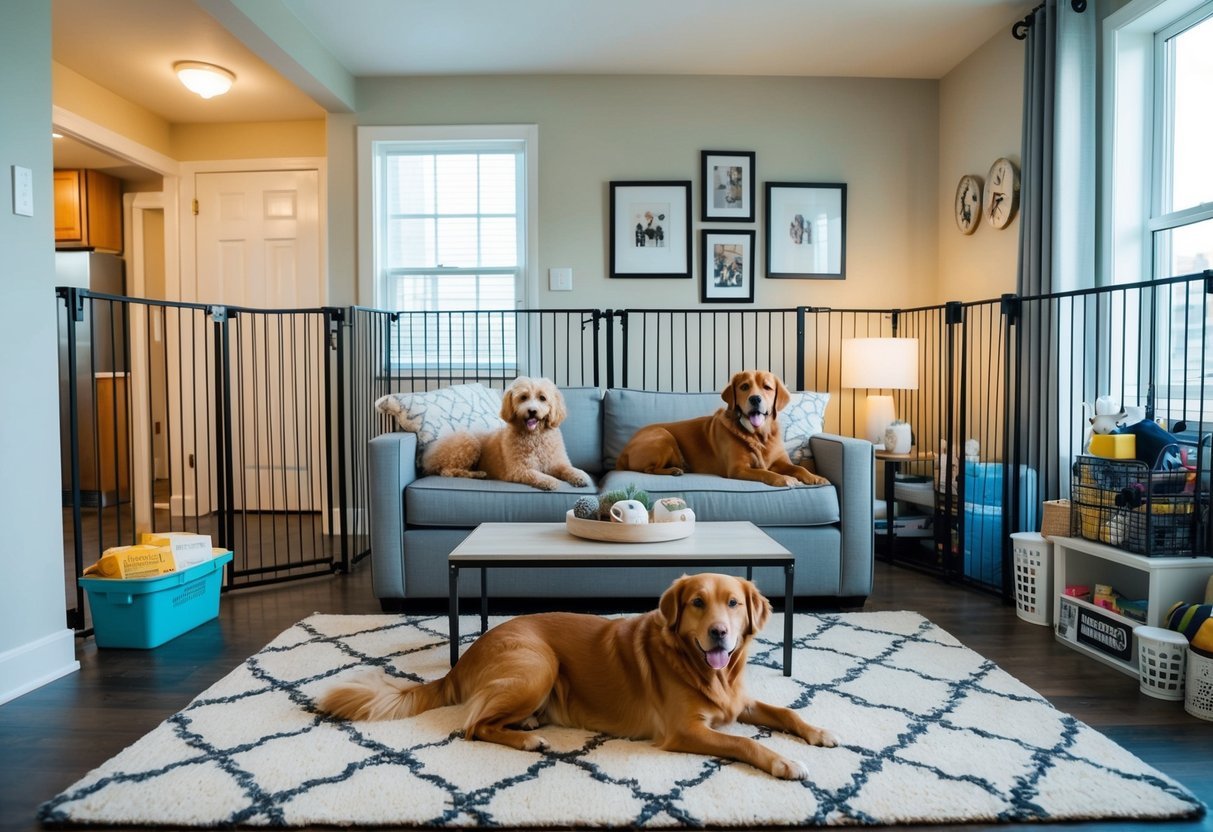
Having multiple dogs in an apartment comes with extra-legal and money responsibilities. I’ve learned it’s important to plan ahead for these issues to avoid problems down the road.
Insurance and Liabilities
I always make sure my renter’s insurance covers multiple dogs. Some policies have limits on the number or types of pets. I check if there are breed restrictions too. It’s smart to get extra liability coverage just in case. I know landlords can be picky about multiple pets. I always get everything in writing in my lease. This protects me if issues come up later.
Some cities have laws about how many dogs you can have. I look into local regulations before adding more pups to my pack. Breaking these rules could mean fines or even losing my dogs.
Budgeting for Multiple Pets
Feeding two or more dogs costs a lot more than one. I budget extra for high-quality food to keep them healthy. Vet bills add up fast too. I set aside money each month for routine care and emergencies. I’ve found that multi-dog households need careful planning. Things like toys, beds, and grooming supplies cost more. I factor these into my budget too.
Training costs are another expense. Group classes can save money, but sometimes I need one-on-one help. I include this in my pet budget as well.
Community and Neighbor Relations

Living in an apartment with multiple dogs can be tricky. I’ve learned that good relationships with neighbors are key. Here are some tips I use to keep everyone happy:
- Be proactive and introduce yourself and your dogs to neighbors
- Ask about any concerns they might have
- Offer your contact info in case of issues
I always make sure my dogs are well-trained and socialized. This helps prevent barking and other disruptive behaviors. When we’re in common areas, I keep my pups on short leashes and under control. Cleaning up after my dogs is a must. I carry extra bags and clean any messes right away. This keeps shared spaces nice for everyone.
I try to be mindful of noise. During quiet hours, I limit playtime and keep barking to a minimum. If my dogs get noisy, I address it quickly. Sometimes, I invite neighbors to meet my dogs in a controlled setting. This helps build positive relationships and understanding.
Traveling with Multiple Dogs
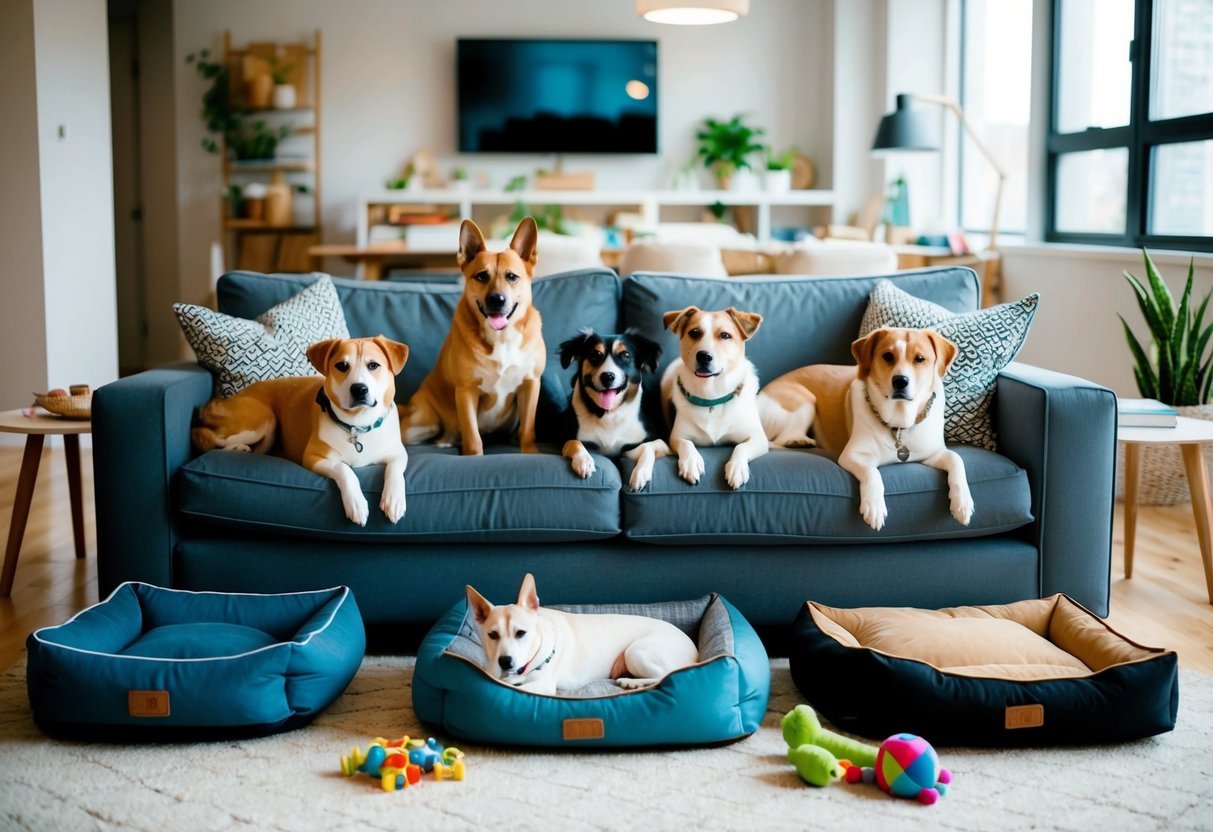
Hitting the road with multiple pups can be an adventure! I’ve learned a few tricks to make trips smoother for everyone. First, I always pack a separate bag for each dog. This includes:
- Food and treats
- Leash and collar
- Favorite toy
- Water bowl
I find it helps to keep each dog’s belongings organized and easily accessible. When it comes to car rides, safety is key. I use sturdy crates or doggy seatbelts for each of my furry friends. This keeps them secure and prevents distractions while driving.
I plan plenty of potty breaks along the way. It’s a chance for everyone to stretch their legs and burn off some energy. I always bring waste bags and make sure to clean up after my pups. If we’re staying in hotels, I call ahead to confirm their pet policies. Some places have limits on the number or size of dogs allowed. I also bring blankets to cover furniture and protect against any accidents.
Lastly, I make sure all my dogs’ vaccinations are up-to-date before we travel. It’s important to be prepared for any health issues that might come up on the road. With a little planning, traveling with multiple dogs can be a tail-wagging good time!
When to Seek Professional Help

Living with multiple dogs in an apartment can be tricky. Sometimes, we need a little extra help to make things run smoothly. Here are some signs that it might be time to call in a pro:
- Constant fighting between dogs
- Excessive barking that won’t stop
- Destruction of furniture or belongings
- Severe anxiety in one or more dogs
- Difficulty with basic commands or training
If you’re seeing any of these issues, don’t worry! It’s totally normal to need help sometimes. Professional pet trainers can offer great advice for multi-dog homes. I’ve found that trainers can teach us new tricks for managing our furry friends. They might suggest:
- Special training classes for multiple dogs
- Ways to set up your apartment for better dog flow
- Techniques to reduce stress and conflict
Remember, asking for help doesn’t mean you’re a bad pet parent. It shows how much you care! Professional guidance can be super helpful in creating a happy home for everyone. Even if things seem okay, a check-in with a pro can be a good idea. They might spot little things we’ve missed that could become bigger problems later on.
Fun Fact
Did you know that living in close quarters can actually deepen the bond between dogs? In smaller spaces, dogs are more attuned to each other’s body language and behaviors, learning to communicate and coexist more effectively. This constant proximity helps them pick up on subtle cues, fostering stronger relationships and promoting a more harmonious pack dynamic.

Pack Peace: Creating Harmony in Multi-Dog Apartment Living
Living with multiple dogs in an apartment might seem tricky at first, but with a little patience, planning, and creativity, it can totally work! By setting routines, creating cozy spaces for each dog, and keeping the peace with smart management, you’ll have a happy and harmonious pack in no time. Remember, it’s all about balance—your pups don’t need a mansion, just a loving environment where they feel safe and connected. So embrace the adventure, and enjoy the extra tail wags and snuggles that come with multi-dog living in small spaces!
Ready to create a harmonious home for your multi-dog household? Share your tips and experiences with our community. Let’s inspire each other to provide the best possible living environment for our furry friends.
Frequently Asked Questions
Living with multiple dogs in an apartment can be challenging. I’ve found some key strategies that help make it work. Here are answers to common questions about managing a multi-dog household in a smaller space.
How can you effectively manage aggression in a multi-dog household?
I always keep a close eye on my dogs’ body language. If I notice tension, I redirect them to separate activities. Teaching dogs to be nice to each other is crucial. I reward calm behavior and give time-outs for bullying. Consistent training helps prevent fights. I make sure each dog knows basic commands. This gives me more control in tense situations.
What techniques work best for training multiple dogs at the same time?
I start by training each dog individually in a quiet space. Once they master commands, I gradually add distractions. Then I bring in another dog, then another. Group training sessions are great for reinforcing skills. I keep sessions short and fun. Treats help maintain focus.
What are the best strategies for walking two or more dogs together?
I use sturdy leashes and harnesses for control. Walking side-by-side prevents tangling. I start with short walks to build good habits. Proper leash training is key. I teach each dog to walk nicely alone first. Then I combine them gradually.
Can you share some tips for potty training multiple dogs in an apartment setting?
I split up the text into at most two sentences per paragraph. This makes it easier to read. I create a consistent schedule for potty breaks. Each dog gets individual attention during training. I use separate potty areas if possible to avoid confusion. Positive reinforcement works wonders. I praise and reward each dog for going to the right spot. Patience is crucial – accidents will happen.
How can you reduce barking and maintain peace among dogs living together in an apartment?
I provide plenty of mental and physical exercise. Tired dogs are less likely to bark excessively. Puzzle toys keep them occupied when I’m busy. Teaching a “quiet” command is helpful. I reward calm behavior and ignore attention-seeking barks.
What are the dynamics to consider when managing a household with three or more dogs?
I make sure each dog gets one-on-one time with me daily. This prevents jealousy and strengthens our bond. I’m always aware of the pack hierarchy. Resource management is crucial. I provide enough toys, beds, and feeding stations to avoid conflicts. Supervision during mealtimes helps maintain peace.
